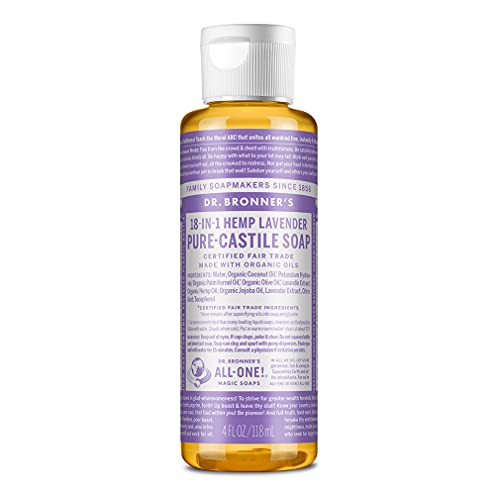
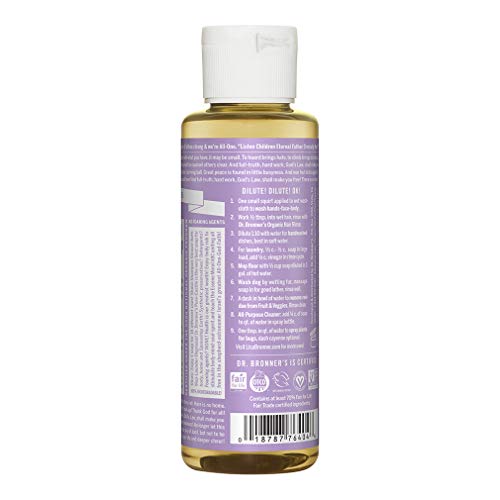
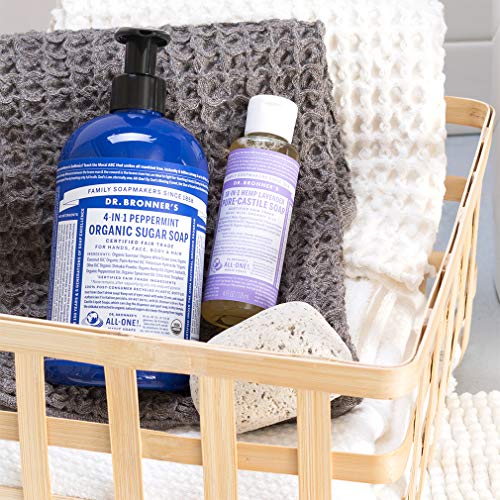

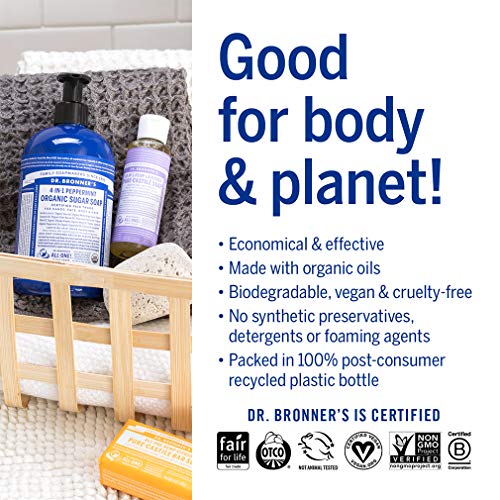
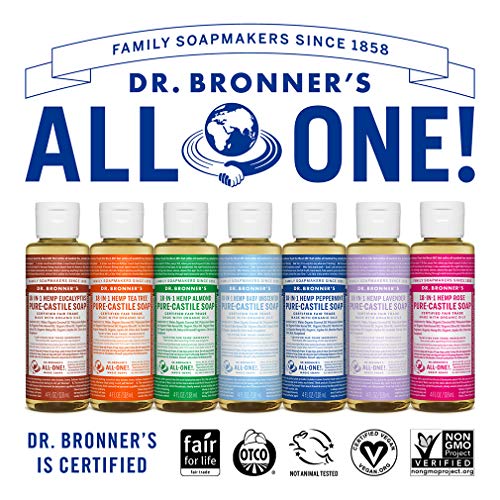
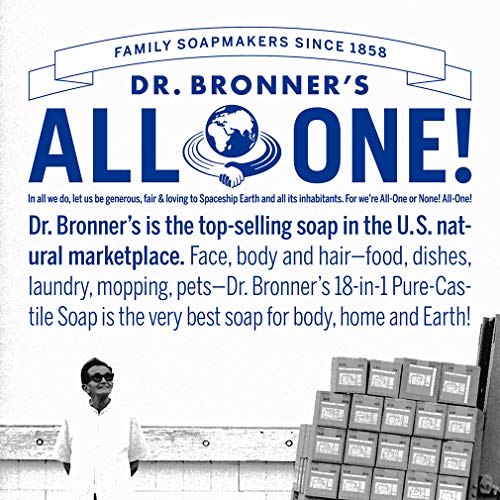
Dr. Bronner's Body Soap - Organic Oils, Fair Trade Ingredients, 18-in-1 Uses - Lavender, 4oz


Rosmarinus Officinalis (Rosemary) Leaf Extract
Medium RiskRosemary leaf extract is produced from the leaves of the Rosmarinus officinalis plant. It is commonly used in cosmetic formulations for its potential antioxidant properties and fragrance. The extract may also contribute to the preservation of products due to its antimicrobial characteristics.
Sustai Insights
Rosemary leaf extract offers functional benefits such as antioxidant and antimicrobial properties, which can enhance product stability and shelf-life. It is generally considered low risk for carcinogenicity and reproductive toxicity, but it carries a moderate potential for allergic reactions. Environmentally, it poses low risk with no significant pollutant or bioaccumulation concerns. Regulatory bodies have not placed significant restrictions on its use, although some verified products cannot contain certain concentrations. Overall, the ingredient's risk level is medium, necessitating careful usage practices to mitigate allergic responses.
Fatty Acids
Low RiskFatty acids are organic compounds composed of long hydrocarbon chains with a carboxyl group at one end. They serve various functions in cosmetic formulations, including acting as emollients, emulsifiers, and surfactants, contributing to product texture and stability.
Sustai Insights
Fatty acids offer functional benefits such as enhancing skin hydration and improving product consistency. They are generally recognized as safe by regulatory bodies, with low concerns regarding carcinogenicity, allergies, and reproductive toxicity. Environmental risks are minimal, as they are often biodegradable and not bioaccumulative. Regulatory agencies have not issued significant warnings against their use. Overall, fatty acids present a low risk profile, making them a favorable choice in cosmetic applications. Safe usage practices should be followed, and alternatives include plant-based oils for sustainability.
Vegetarian Glycerin
Low RiskVegetarian glycerin, also known as glycerol, is a colorless, odorless, and viscous liquid derived from plant sources. It is primarily used as a humectant, solvent, and emollient in various personal care products, helping to retain moisture and improve texture.
Sustai Insights
Vegetarian glycerin offers functional benefits as an effective humectant, promoting hydration and skin smoothness. It is biodegradable and typically sustainably sourced. Health risks associated with glycerin are low, with no significant concerns for carcinogenicity, allergens, or reproductive toxicity. Environmental risks are minimal, and it is not subject to major regulatory warnings. Overall, the risk level for this ingredient is low, making it a safe choice in formulations. Safe usage practices include ensuring proper concentrations in products, and alternatives such as propylene glycol exist but may have differing properties.
Olea Europaea (Olive) Oil
Low RiskOlea europaea (olive) oil is derived from the ripe fruit of the olive tree. It is commonly used in cosmetic formulations primarily as a moisturizer and emollient due to its nourishing properties for the skin. It also serves as a carrier oil for other ingredients in formulations.
Sustai Insights
Olea europaea (olive) oil offers numerous functional benefits, including effective moisturization and enhanced skin absorption properties, making it suitable for various cosmetic applications. It is a biodegradable ingredient, contributing to sustainability when sourced responsibly. Health risks are low, with minimal concerns regarding carcinogenicity, allergenic potential, and developmental toxicity. Environmental risks are also low, with no significant bioaccumulation or pollution potential noted. Regulatory bodies do not impose restrictions on its use. Overall, olive oil presents a low risk profile, making it a favorable choice in cosmetic products.
Water
Low RiskWater is a clear, colorless liquid essential for various biological processes. It serves as a solvent in formulations, facilitating the dissolution of other ingredients and enhancing product texture and application. Additionally, water plays a crucial role in hydration and is a key component in many cosmetic and personal care products.
Sustai Insights
Water is an effective solvent and hydrator, contributing to the texture and efficacy of formulations. It is biodegradable and generally regarded as safe, with low concerns regarding carcinogenicity, allergies, and reproductive toxicity. However, excessive water usage can lead to environmental concerns, particularly regarding resource depletion. Regulatory bodies do not impose restrictions on water use in cosmetics. Overall, the risks associated with water are low, making it a safe and essential ingredient.
Lavandula (Lavender) Flower
Low RiskLavandula (lavender) flower refers to unspecified preparations of the lavender plant, known for its aromatic properties. It is commonly used in various products for fragrance and potential therapeutic benefits, such as calming effects. The ingredient has a low risk profile regarding common health concerns.
Sustai Insights
Lavender flower offers functional benefits primarily as a fragrance and potential calming agent in products. It is considered sustainably sourced with low environmental impact and is not associated with significant health risks, such as carcinogenicity, allergies, or reproductive toxicity. Regulatory bodies, including the FDA, do not impose restrictions on its use. However, as with any ingredient, proper usage is recommended to mitigate any minor irritation risks. Overall, it presents a low-risk profile, making it a favorable choice in formulations.
Fatty Acids
Low RiskFatty acids are organic compounds composed of long hydrocarbon chains with a carboxyl group at one end. They serve various functions in cosmetic formulations, including acting as emollients, emulsifiers, and surfactants, contributing to product texture and stability.
Sustai Insights
Fatty acids offer functional benefits such as enhancing skin hydration and improving product consistency. They are generally recognized as safe by regulatory bodies, with low concerns regarding carcinogenicity, allergies, and reproductive toxicity. Environmental risks are minimal, as they are often biodegradable and not bioaccumulative. Regulatory agencies have not issued significant warnings against their use. Overall, fatty acids present a low risk profile, making them a favorable choice in cosmetic applications. Safe usage practices should be followed, and alternatives include plant-based oils for sustainability.
Rosmarinus Officinalis (Rosemary) Leaf Extract
Medium RiskRosemary leaf extract is produced from the leaves of the Rosmarinus officinalis plant. It is commonly used in cosmetic formulations for its potential antioxidant properties and fragrance. The extract may also contribute to the preservation of products due to its antimicrobial characteristics.
Sustai Insights
Rosemary leaf extract offers functional benefits such as antioxidant and antimicrobial properties, which can enhance product stability and shelf-life. It is generally considered low risk for carcinogenicity and reproductive toxicity, but it carries a moderate potential for allergic reactions. Environmentally, it poses low risk with no significant pollutant or bioaccumulation concerns. Regulatory bodies have not placed significant restrictions on its use, although some verified products cannot contain certain concentrations. Overall, the ingredient's risk level is medium, necessitating careful usage practices to mitigate allergic responses.
Vegetarian Glycerin
Low RiskVegetarian glycerin, also known as glycerol, is a colorless, odorless, and viscous liquid derived from plant sources. It is primarily used as a humectant, solvent, and emollient in various personal care products, helping to retain moisture and improve texture.
Sustai Insights
Vegetarian glycerin offers functional benefits as an effective humectant, promoting hydration and skin smoothness. It is biodegradable and typically sustainably sourced. Health risks associated with glycerin are low, with no significant concerns for carcinogenicity, allergens, or reproductive toxicity. Environmental risks are minimal, and it is not subject to major regulatory warnings. Overall, the risk level for this ingredient is low, making it a safe choice in formulations. Safe usage practices include ensuring proper concentrations in products, and alternatives such as propylene glycol exist but may have differing properties.
Olea Europaea (Olive) Oil
Low RiskOlea europaea (olive) oil is derived from the ripe fruit of the olive tree. It is commonly used in cosmetic formulations primarily as a moisturizer and emollient due to its nourishing properties for the skin. It also serves as a carrier oil for other ingredients in formulations.
Sustai Insights
Olea europaea (olive) oil offers numerous functional benefits, including effective moisturization and enhanced skin absorption properties, making it suitable for various cosmetic applications. It is a biodegradable ingredient, contributing to sustainability when sourced responsibly. Health risks are low, with minimal concerns regarding carcinogenicity, allergenic potential, and developmental toxicity. Environmental risks are also low, with no significant bioaccumulation or pollution potential noted. Regulatory bodies do not impose restrictions on its use. Overall, olive oil presents a low risk profile, making it a favorable choice in cosmetic products.
Water
Low RiskWater is a clear, colorless liquid essential for various biological processes. It serves as a solvent in formulations, facilitating the dissolution of other ingredients and enhancing product texture and application. Additionally, water plays a crucial role in hydration and is a key component in many cosmetic and personal care products.
Sustai Insights
Water is an effective solvent and hydrator, contributing to the texture and efficacy of formulations. It is biodegradable and generally regarded as safe, with low concerns regarding carcinogenicity, allergies, and reproductive toxicity. However, excessive water usage can lead to environmental concerns, particularly regarding resource depletion. Regulatory bodies do not impose restrictions on water use in cosmetics. Overall, the risks associated with water are low, making it a safe and essential ingredient.
Lavandula (Lavender) Flower
Low RiskLavandula (lavender) flower refers to unspecified preparations of the lavender plant, known for its aromatic properties. It is commonly used in various products for fragrance and potential therapeutic benefits, such as calming effects. The ingredient has a low risk profile regarding common health concerns.
Sustai Insights
Lavender flower offers functional benefits primarily as a fragrance and potential calming agent in products. It is considered sustainably sourced with low environmental impact and is not associated with significant health risks, such as carcinogenicity, allergies, or reproductive toxicity. Regulatory bodies, including the FDA, do not impose restrictions on its use. However, as with any ingredient, proper usage is recommended to mitigate any minor irritation risks. Overall, it presents a low-risk profile, making it a favorable choice in formulations.
Experience the gentle touch of Dr. Bronner's Pure-Castile Liquid Soap in soothing Lavender. This versatile soap, made with over 70% organic and fair trade ingredients, is perfect for the environmentally conscious consumer seeking quality and sustainability.
- Versatile Use: This concentrated soap can clean your face, body, hair, laundry, and even your pets, maximizing value and minimizing waste.
- Organic Ingredients: Crafted with organic and fair trade palm kernel oil, it supports sustainable farming practices, ensuring a positive impact on local communities.
- Skin-Friendly Formula: Free from synthetic preservatives and foaming agents, this plant-based soap is gentle on the skin, making it suitable for all skin types.
- Eco-Conscious Packaging: Packaged in 100% post-consumer recycled plastic, Dr. Bronner’s reduces waste and promotes a circular economy.
- Concentration Power: Three times more concentrated than most liquid soaps, a little goes a long way, making it cost-effective while reducing environmental footprint.
Subscribe & Save with Sustai
- Best Price Guarantee: Always enjoy the lowest prices on sustainable home essentials.
- No Surprises: We’ll notify you before shipping. No hidden fees, ever.
- You’re in Charge: Change, pause, or cancel your subscription anytime with ease.
- Eco-Friendly Deliveries: Our grouped shipments mean less packaging and lower emissions.
Join us on a sustainable journey. Special offers for a limited time! Prices and promotions may change.
Recommended Products
Experience the gentle touch of Dr. Bronner's Pure-Castile Liquid Soap in soothing Lavender. This versatile soap, made with over 70% organic and fair trade ingredients, is perfect for the environmentally conscious consumer seeking quality and sustainability.
- Versatile Use: This concentrated soap can clean your face, body, hair, laundry, and even your pets, maximizing value and minimizing waste.
- Organic Ingredients: Crafted with organic and fair trade palm kernel oil, it supports sustainable farming practices, ensuring a positive impact on local communities.
- Skin-Friendly Formula: Free from synthetic preservatives and foaming agents, this plant-based soap is gentle on the skin, making it suitable for all skin types.
- Eco-Conscious Packaging: Packaged in 100% post-consumer recycled plastic, Dr. Bronner’s reduces waste and promotes a circular economy.
- Concentration Power: Three times more concentrated than most liquid soaps, a little goes a long way, making it cost-effective while reducing environmental footprint.

You can have at most 2 Sustainable Steals products in your cart
Customer Reviews
Customers’ View
Customers appreciate the effectiveness and eco-friendly nature of this body soap, often highlighting its pleasant lavender scent and multi-purpose capabilities. Many users note its strong cleaning power, stating it leaves them feeling clean and refreshed, with one customer mentioning, 'It rinses easy and can be used for lots of different things.' The soap is also praised for its organic and fair trade ingredients, aligning with health-conscious values. However, some customers report mixed feelings about its skin softening properties and value for money, with a few mentioning that while the soap is effective, the 4 oz size feels overpriced. Overall, customers find this product effective and aligned with sustainable lifestyle choices.
AI-generated from the text of customer reviewsThis product has no reviews yet.




